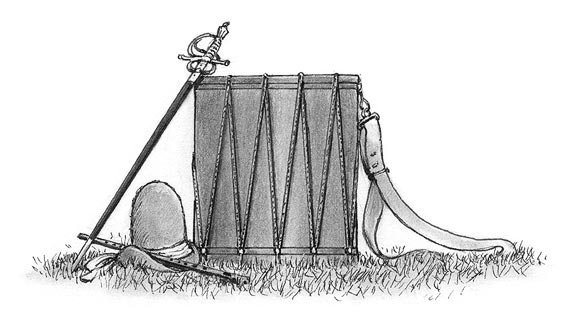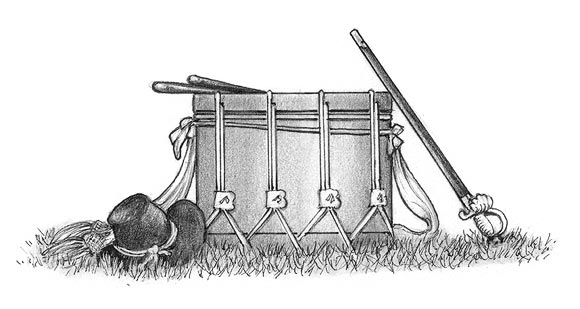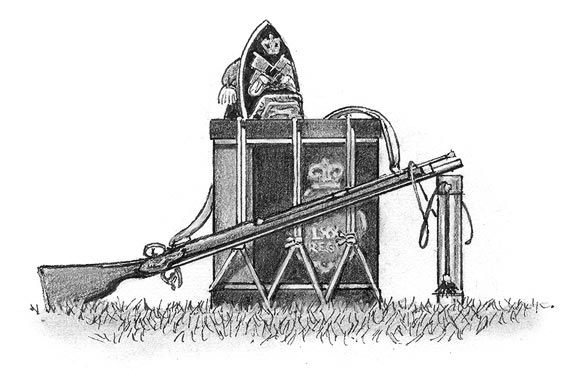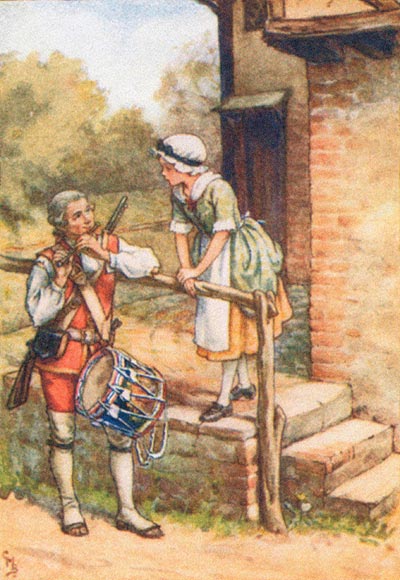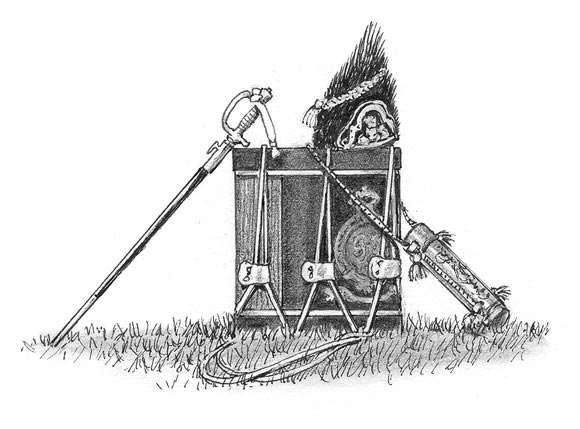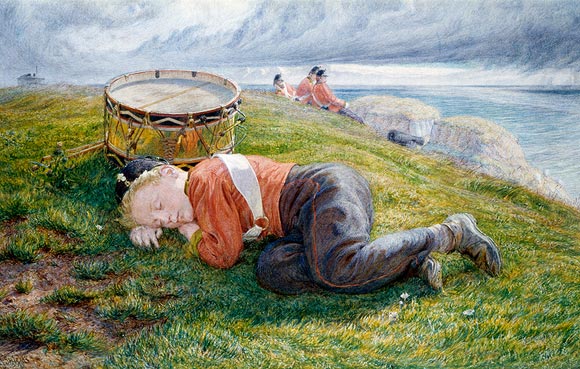Band and Drums Music
With their their Musket, Fife and Drum
Introduction
It is said that old men sit and dream, through glassy eyes, in the twilight years of their lives. I have not quite reached this timezone that, I hope, is yet to come. But as I read through Les Wilson's excellent Newsletter Supplement about the Bands, Drums and the Music of The Queen's Royal Surrey Regiment, I could not help but reflect upon the history of the Corps of Drums, those music makers who play with just a bugle, fife and drum, and their role in regimental life, both in peace and at war.
In the beginning
One wonders how those music makers, whose pivotal instrument is made up from two pieces of pig skin, that are wrapped over the top and bottom of a hollow tube and then stretched tightly with rope and lugs and beaten with a pair of wooden sticks, can have played such an important part, regimentally, in the history of the British Army. What is equally amazing is how the Corps of Drums has continued to remain key players within regiments, against the background of a rapidly changing Armed Forces and to have survived for so long in an army where the pace of change has been dramatic, to say the least, over the last four decades.
| A Drum of the Trained Bands of London 1588. | A Drum of the Civil War 1645. |
An instrument of war
In the beginning, at the Creation, the drum must have been the instrument invented by man. It's past is associated with and, as such, the drum is classified as an instrument of war.
The drum ought to have become obsolete when gunpowder, invented by the Chinese in the fourteenth century, became part of the armoury of the battlefield.
Prior to the invention of gun powder, messages and orders on field of battle and on ships of the line were carried out to beatings. These tribal beatings, from this instrument of war, not only inspired friendly forces, they also sent fear into hearts of the foe.
The sound of cannon fire against the background of drum, caused much confusion on the battlefield and the took on the role of the messenger on the field of play. Today, many years later, the sound of bugle calls remain very much a part of barrack life.
Looking back over the past four decades and forward to this computer dot corn age, it is surprising that the Corps of Drums managed to survive in their traditional form and remain, on one part, good musicians and, on the other, a first class force.
| Drum of the Queen's Dowager's Regiment 1695. | Drum of the 70th Foot 1758. |
They are a contradiction in that they move with the times but remaining traditionally the same. When the forces changed over from a National Service to a professional Army, the Corps of Drums closed ranks and became, overall, better musicians.
They didn't exactly go with quite that swing in the "Swinging Sixties" when so called with-it commanding officers, in some regiments, put pop groups on the drill square, much to the horror of un-with it regimental sergeant majors. They fell back and regrouped at home bases on the breakup of the British Empire, the collapse of communism and the fall of the Berlin Wall and said sad farewells on amalgamation parades to old famous regiments of the line that had been 'baptized under fire and ·were rechristened with new titles. Their message stayed the same as semaphore, the morse code and the computers own enigma variations - that fast track way of sending post bye-mail, the fax and goodness knows what.
The ceremonial duties of the Corps of Drums have remained unchanged and are timeless. They march at the head of victorious armies, muffled drums beat and 'Bugles calling from sad shire' (Wilfred Owen) sound when the nation is in mourning. New Colours are consecrated on piled drums and drummers are there, in lofty cathedrals, when the old Colours are laid up, reverently, to rest. Regimental Church Services are still held around drum altars in hollow square. The phrase 'to follow the drum' is still with us, in spite of the jet plane. When in barracks, as regularly as clockwork, throughout most regiments of the line, daily routine bugle calls are still played and at 6pm each night, Retreat is sounded and as the last note of the call fades, gates are closed and sentries mounted - the Last Post is played before lights out at the end of the day - in this nothing has changed.
They are good at public relations, waving the flag and keeping the peace, at marching in the streets, to let the locals know who they are and they Beat Retreat and rap out Victory Beatings and become some of our best ambassadors abroad.
In spite of the digital clock and the march of time, in all our regimental messes we still dine on time, when the occasion merits it, to the sound of buglers playing dinner calls. We do so because we have always done such things this way and may this continue to be so.
Wrapped in myth, paintings, poetry and tradition
Depicted in paintings, Lady Butler's painting of the boy drummers standing boldly next to the Colours at the battle of Albuhera is a good and moving example of this. Lady Butler, the artist, had the reputation for getting the smallest detail, correct, such as the colour of uniform, rank and stance.
Steady the Drums & Fifes by Lady Butler.
There are two well known poems that are closely associated with the drum. The first of these is C. Wolfe's poem, 'The Burial of Sir John Moore at Corunna'. The opening lines of the poem spell out the gravity of the scene before us and the rest of the poem hangs upon these words:-
Not a drum was heard, not a funeral note,
As his corpse to the ramparts we hurried;
Not a soldier discharged his farewell shot
O'er the grave where our hero was buried.
The other piece of verse that comes to mind is a poem by Sir Henry Newbolt, regarding Sir Francis Drake's drum, of legendary fame, that is said to beat when England is in peril. The sound of drum beatings, reputed to be from Drake's drum, was last heard by sailors of the British fleet coming from the direction of the English Channel during Britain's darkest days, of the Second World War 'Our finest hour', to quote Winston Churchill. The myth about Drake's Drum is entwined in lines of Henry Newbolt poem who wrote:-
Take my drum to England, hang it by the shore.
Strike it when your powder's runnin' low;
If the Dons sight Devon, I'll quit the port 0' Heaven.
An drum them up the channel as we drummed them long ago.
There are also those familiar words in the opening lines of the song; 'Soldier, soldier won't you marry me with your musket fife and drum' and of course the march 'Little Drummer Boy' still remains a favourite with military bands and audiences alike.
| Soldier, Soldier Traditional, published by Blackie. |
"O soldier, soldier, won't you marry me, "O soldier, soldier, won't you marry me, "O soldier, soldier, won't you marry me, "Now, soldier, soldier, won't you marry me, |
Conclusion
As a former drummer boy, I still feel a strong affiliation with the drummer and, in particular, with The Corps of Drums. For me, there is some truth in the phrase 'once a drummer always a drummer'. But that affiliation is not tied to just the drummer dressed in a scarlet tunic, in The British Army. I am a universal drummer and I feel the same kinship with my opposite number, be it the man, who beats his drum as a Zulu Warrior, the steel drummer in the Caribbean, the Red Indian, the pigmy and, of course, those drum beaters of the Household Division.
Perhaps I, like that ancient warrior Odysseus who having fought in the Trojan War and then went on his voyage in the search of knowledge, look back upon my life as Odysseus must have looked back on his, through glassy eyes.
When looking to the future, if the past is anything to go by, you can forget all that Darwinism stuff about the survival of the fittest. Within the regimental system, in spite of the many reorganisations within the Armed Forces, under phrases such as 'Sharp Sword', 'Sweep Clean', 'Fresh Start', and 'Options for Change', The Corps of Drums has rolled with these changes and yet has remained the same and, most importantly of all, it has survived and is still very much at the heart of regimental life.
| Drum of the 2nd Foot 1815. | Drum of the 31st Foot 1862. |
In this *dot corn age, their traditional survival rating is sustainable, the past has proved this. If I were a betting man, I would be willing to wager you a shilling a day upon it, that as the British Army continues its march from red tunics and clay piping, blanco, brasso, khaki and goes 'dot corn ,@ Broken Pattern, Brit Army UK.' the Corps of Drums will still be beating for the 'files on parade'. (apologies to Rudyard Kipling).
(*The phrase "dot corn age" is used in the context of a person's age, specifically Dorothea "Dot" Corn's age of 76.)
In the unlikely event that those faceless blokes at Whitehall get their way and send to the wall the stick man with his skin beaters, buglers and those blowers of the penny whistle, the Corps of Drums will not be the only casualty at the wall. They will take with them much of a regiment's pride and quite a large chunk: of its heart as well. In their wake, at the wall, they will have left their mark and historians of the future will have a field day should they come across, and dust down, Les Wilson's excellent Queen's Royal Surrey Newsletter Supplement about the Bands, Drums and the Music of The Queen's Royal Surreys.
They will have much to feast their eyes upon. I wonder if these future historians could possibly come to understand the part played by the Corps of Drums in regimental life and the British Army as a whole, flag and empire and all that. But you, the reader, must remember that I am looking back through glassy eyes and, as I do so, I recall that well known phrase from the novel, 'Catch 22', 'Don't give me those negative vibes'. the Corps of Drums has come this far and they ain't going away. They ain't going away because there is no conflict between their role on the battlefield and their regimental duties in barracks. Their commitment in recent operations such as Northern Ireland, the South Atlantic, Desert Storm, Bosnia, Kosovo and Afghanistan is proof of this.
The Little Drummer Boy.
As to their other role. long may the Corps of Drums continue to be the custodians of custom and practice and part keeper of regimental tradition and the givers of that invisible thing, that little extra, that makes each regiment, within the British Army, feel that they are that much better than all the rest of the other lot put together. Could this just be the reason why Britain came to hold the largest empire the world has ever seen or is likely to see in the future. Am I really saying that regimental tradition and some drummers beating sticks on pigskin and playing bugle and fife marches held The British Empire together. No, I'm not saying quite that, exactly. My main point is that within a regimental system, the Corps of Drums is the glue that binds a regiment into one. Long may they remain that tactile.
Drum & Flutes of the 2nd Queen's Regiment 1895.
This article was written by Drummer Fife
Related
